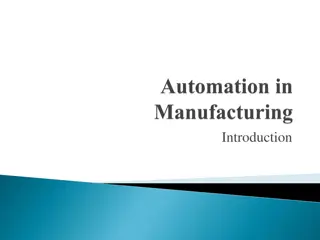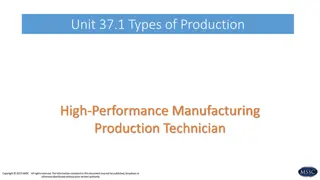Understanding Job Order Cost Flow in Manufacturing
Job costing in manufacturing involves assigning manufacturing costs to work in process through debits to work in process inventory and credits to raw materials inventory, factory labor, and manufacturing overhead. Job cost sheets are used to record costs chargeable to specific jobs, acting as a subsidiary ledger for the work in process account. Direct and indirect materials, as well as factory labor costs, are assigned to jobs based on materials requisition slips and time tickets, respectively. Ensuring accurate tracking and allocation of costs is essential for effective job costing in manufacturing.
Download Presentation

Please find below an Image/Link to download the presentation.
The content on the website is provided AS IS for your information and personal use only. It may not be sold, licensed, or shared on other websites without obtaining consent from the author. Download presentation by click this link. If you encounter any issues during the download, it is possible that the publisher has removed the file from their server.
E N D
Presentation Transcript
Lecture 6 Job Costing 1
Job Order Cost Flow Assigning Manufacturing Costs to Work in Process Manufacturing costs are assigned to Work in Process with Debits to Work in Process Inventory Credits to Raw Materials Inventory Factory Labor Manufacturing Overhead 2
Job Order Cost Flow Job Cost Sheet Used to record costs chargeable to specific jobs. Constitutes the subsidiary ledger for the work in process account. Each entry to a Work in Process Inventorymust be accompanied by a corresponding posting to one or more job cost sheets. 3
Job Order Cost Flow Assigning Manufacturing Costs to WIP Raw Material Costs Assigned to a job when materials are issued Materials requisition slip Written authorization for issuing raw materials. May be directly issued to use on a job - direct materials. May be considered indirect materials part of manufacturing overhead. 5
Job Order Cost Flow Assigning Raw Material Costs Illustration: Wallace uses $24,000 of direct materials and $6,000 of indirect materials in January, the entry is: Jan. 31 Work in Process Inventory 24,000 Manufacturing Overhead 6,000 Raw Materials Inventory 30,000 7
Job Order Cost Flow Assigning Raw Materials Cost The sum of the direct materials columns of the job cost sheets should equal the direct materials debited to Work in Process Inventory. 8
Job Order Cost Flow Factory Labor Costs Assigned to jobs on the basis of time tickets Time tickets are prepared when the work is performed Time tickets indicate Employee Hours worked Account and job charged Total labor cost 10
Job Order Cost Flow Factory Labor Costs Illustration: The time tickets are later sent to the payroll department, which applies the employee s hourly wage rate and computes the total labor cost. If the $32,000 total factory labor cost consists of $28,000 of direct labor and $4,000 of indirect labor, the entry is: Jan. 31 Work in Process Inventory 28,000 Manufacturing Overhead 4,000 Factory Labor 32,000 12
Job Order Cost Flow Factory Labor Costs Jan. 31 Work in Process Inventory 28,000 Manufacturing Overhead 4,000 Factory Labor 32,000 13
Job Order Cost Flow Job Cost Sheets Direct Labor The sum of the direct labor columns of the job cost sheets should equal the direct labor debited to Work in Process Inventory. 14
Job Order Cost Flow Review Question The source documents for assigning material and factory labor costs to job cost sheets are: a. Invoices and time tickets. b. Invoices and payroll register. c. Materials requisition slips and payroll register. d. Materials requisition slips and time tickets. 15
Job Order Cost Flow Manufacturing Overhead Costs Relates to production operations as a whole. Cannot be assigned to specific jobs based on actual costs incurred. Companies assign to work in process and to specific jobs on an estimated basis through the use of a Predetermined Overhead Rate 16
Job Order Cost Flow Predetermined Overhead Rate Based on the relationship between estimated annual overhead costs and expected annual operating activity Expressed in terms of an activity base such as Direct labor costs Direct labor hours Machine hours Any other activity that is an equitable base for applying overhead costs to jobs 17
Job Order Cost Flow Predetermined Overhead Rate Established at the beginning of the year. May use a single, company-wide predetermined rate. May use a different rate for each department and each department may have a different activity base. Formula for computing the predetermined rate overhead rate is 18
Job Order Cost Flow Manufacturing Overhead Costs Assigned to Work in Process during the period to get timely information about the cost of a completed job. Illustration 2-10 19
Job Order Cost Flow Manufacturing Overhead Costs Illustration: Wallace uses direct labor cost as the activity base. Assuming that the company expects annual overhead costs to be $280,000 and direct labor costs for the year to be $350,000, compute the overhead rate. $280,000 $350,000 = 80% This means that for every dollar of direct labor, Wallace will assign _______ of manufacturing overhead to a job. 80 cents 20
Job Order Cost Flow Manufacturing Overhead Costs Illustration: Wallace applies manufacturing overhead to work in process when it assigns direct labor costs. Calculate the amount of applied overhead assuming direct labor costs were $28,000. $28,000 x 80% = $22,400 The following entry records this application. Jan. 31 Work in Process Inventory 22,400 Manufacturing Overhead 22,400 21
Job Order Cost Flow Illustration 2-11 Manufacturing Overhead Costs The sum of the manufacturing overhead columns of the job cost sheets should equal the manufacturing overhead debited (i.e., applied) to Work in Process Inventory. 22
Job Order Cost Flow Manufacturing Overhead Costs At the End of Each Month: The balance in the Work in Process Inventory should equal the sum of the costs shown on the job cost sheets of unfinished jobs. 23
Job Order Cost Flow Review Question The formula for computing the predetermined manufacturing overhead rate is estimated annual overhead costs divided by an expected annual operating activity, expressed as: a. Direct labor cost. b. Direct labor hours. c. Machine hours. d. Any of the above. 24
Danielle Company is working on two job orders. The job cost sheets show the following: Direct materials Job 120 $6,000; Job 121 $3,600 Direct labor Job 120 $4,000; Job 121 $2,000 Manufacturing overhead Job 120 $5,000; Job 121 $2,500 Prepare the three summary entries to record the assignment of costs to Work in Process from the data on the job cost sheets. 25
The three summary journal entries are: Work in Process Inventory 9,600 Raw Materials Inventory 9,600 Work in Process Inventory 6,000 Factory Labor 6,000 Work in Process Inventory 7,500 Manufacturing Overhead 7,500 26
Job Order Cost Flow Assigning Costs to Finished Goods When a job is completed, the costs are summarized and the job cost sheet is completed. 27
Job Order Cost Flow Assigning Costs to Finished Goods Illustration: When a job is finished, Wallace makes an entry to transfer its total cost to finished goods inventory. Jan. 31 Finished Goods Inventory 39,000 Work in Process Inventory 39,000 28
Job Order Cost Flow Assigning Costs to Cost of Goods Sold Illustration: On January 31 Wallace Manufacturing sells on account Job 101. The job cost $39,000, and it sold for $50,000. The entries to record the sale and recognize cost of goods sold are: Jan. 31 Accounts Receivable 50,000 Sales revenue 50,000 Cost of Goods Sold 39,000 Finished Goods Inventory 39,000 29
Job Order Cost Flow Review Question In M Company, Job No. 26 is completed at a cost of $4,500 and later sold for $7,000 cash. A correct entry is: a. Debit Finished Goods Inventory $7,000 and credit Work in Process Inventory $7,000. b. Debit Cost of Goods Sold $7,000 and credit Finished Goods Inventory $7,000. c. Debit Finished Goods Inventory $4,500 and credit Work in Process Inventory $4,500. d. Debit Accounts Receivable $7,000 and credit Sales $7,000. 30
Job Order Cost Flow Summary Illustration 2-15 31
Job Order Cost Flow Summary 32
During the current month, Onyx Corporation completed Job 109 and Job 112. Job 109 cost $19,000 and Job 112 costs $27,000. Job 112 was sold on account for $42,000. Journalize the entries for the completion of the two jobs and the sale of Job 112. Finished Goods Inventory Work in Process Inventory 46,000 46,000 Accounts Receivable Sales 42,000 42,000 Cost of Goods Sold Finished Goods Inventory 27,000 27,000 33
Job Order Cost Flow Job Order Costing for Service Companies While service companies do not have inventory, the techniques of job order costing are still quite useful in many service-industry environments. Consider, for example, the Mayo Clinic (health care), PricewaterhouseCoopers (accounting), and Goldman Sachs (investment banking). 34
Job Order Cost Flow Advantages More precise in assignment of costs to projects than process costing. Provides more useful information for determining the profitability of particular projects and for estimating costs when preparing bids on future jobs. Disadvantage Requires a significant amount of data entry. 36
Reporting Job Cost Data Shows manufacturing overhead appliedrather than actual overhead costs. Applied overhead is added to direct materials and direct labor to determine total manufacturing costs 37
Reporting Job Cost Data Partial Income Statement 38
Reporting Job Cost Data Under- or Overapplied Overhead A debit balance in manufacturing overhead means that overhead is underapplied. A credit balance in manufacturing overhead means that overhead is overapplied. 39
Reporting Job Cost Data Under- or Overapplied Overhead Any Year-End Balance in manufacturing overhead is eliminated by adjusting cost of goods sold. Underapplied overhead is debited to COGS Overapplied overhead is credited to COGS 40
Reporting Job Cost Data Under- or Overapplied Overhead Illustration: Wallace has a $2,500 credit balance in Manufacturing Overhead at December 31. The adjusting entry for the over-applied overhead is: Dec. 31 Manufacturing Overhead 2,500 Cost of Good Sold 2,500 41
Reporting Job Cost Data Review Question Manufacturing overhead is underapplied if: a. Actual overhead is less than applied. b. Actual overhead is greater than applied. c. The predetermined rate equals the actual rate. d. Actual overhead equals applied overhead. 42
For Karr Company, the predetermined overhead rate is 140% of direct labor cost. During the month, Karr incurred $90,000 of factory labor costs, of which $80,000 is direct labor and $10,000 is indirect labor. Actual overhead incurred was $119,000. Compute the amount of manufacturing overhead applied during the month. Determine the amount of under- or overapplied manufacturing overhead. Manufacturing overhead applied (140% x $80,000) = $112,000 Underapplied manufacturing overhead ($119,000 - $112,000) = $7,000 43























